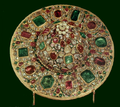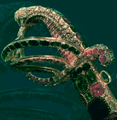Iranian National Jewels: Difference between revisions
Gryffindor (talk | contribs) |
Small spelling corrections |
||
| Line 2: | Line 2: | ||
{{Merge from|The Royal Mace of Iran|discuss=Talk:The Royal Mace of Iran#Merge proposal|date=December 2013}}[[Image:Hat Aigrette.png|thumb|right| An elaborate [[diamond]] and [[emerald]] [[Aigrette]], set in [[silver]]. Part of the Iranian Crown Jewels.]] |
{{Merge from|The Royal Mace of Iran|discuss=Talk:The Royal Mace of Iran#Merge proposal|date=December 2013}}[[Image:Hat Aigrette.png|thumb|right| An elaborate [[diamond]] and [[emerald]] [[Aigrette]], set in [[silver]]. Part of the Iranian Crown Jewels.]] |
||
The '''Imperial crown jewels of Iran''' (''also known as the '''Imperial crown jewels of Persia''''') include several elaborate [[crown (headgear)|crowns]] and decorative [[thrones]], thirty tiaras, and numerous [[aigrette]]s, a dozen |
The '''Imperial crown jewels of Iran''' (''also known as the '''Imperial crown jewels of Persia''''') include several elaborate [[crown (headgear)|crowns]] and decorative [[thrones]], thirty tiaras, and numerous [[aigrette]]s, a dozen bejeweled swords and shields, a vast number of unset precious gems, numerous plates and other dining services cast in precious metals and encrusted with gems, and several other more unusual items (such as a large [[gold]]en globe with the continents made of [[emerald]]s and the latitudes and longitudes marked in [[diamond]]s) collected by the [[History of Iran|Iranian monarchy]] from the 16th century ([[Safavid dynasty]]) on. The collection is housed at The Treasury of National Jewels (the official name) but is known colloquially as the Jewellery Museum. It is situated inside the [[Central Bank of Iran|Central Bank of the Islamic Republic of Iran]] on [[Tehran]]'s Ferdowsi Avenue. The Imperial crown jewels of Iran are the largest set of displayed jewels in the world in state ownership in one location.<ref>http://www.rozanehmagazine.com/JanuaryFebruary06/ANationalJelleries.html</ref> The museum is open to the public from 14:00 to 16:30 hrs except on Wednesday, Thursday and Friday.<ref>http://www.cbi.ir/page/1397.aspx</ref> The museum has onsite guides with knowledge of Persian, English, French and Russian languages. There are also guide booklets available in English, Persian, French, Russian, German, Japanese and Arabic.<ref>{{cite web|url=http://www.cbi.ir/page/4230.aspx#Treasury3_1 |title=پرسشهای متداول |publisher=Cbi.ir |date= |accessdate=2012-08-18}}</ref> |
||
==Safavid and Afsharid Conquests== |
==Safavid and Afsharid Conquests== |
||
Revision as of 23:45, 6 March 2014
It has been suggested that The Royal Mace of Iran be merged into this article. (Discuss) Proposed since December 2013. |

The Imperial crown jewels of Iran (also known as the Imperial crown jewels of Persia) include several elaborate crowns and decorative thrones, thirty tiaras, and numerous aigrettes, a dozen bejeweled swords and shields, a vast number of unset precious gems, numerous plates and other dining services cast in precious metals and encrusted with gems, and several other more unusual items (such as a large golden globe with the continents made of emeralds and the latitudes and longitudes marked in diamonds) collected by the Iranian monarchy from the 16th century (Safavid dynasty) on. The collection is housed at The Treasury of National Jewels (the official name) but is known colloquially as the Jewellery Museum. It is situated inside the Central Bank of the Islamic Republic of Iran on Tehran's Ferdowsi Avenue. The Imperial crown jewels of Iran are the largest set of displayed jewels in the world in state ownership in one location.[1] The museum is open to the public from 14:00 to 16:30 hrs except on Wednesday, Thursday and Friday.[2] The museum has onsite guides with knowledge of Persian, English, French and Russian languages. There are also guide booklets available in English, Persian, French, Russian, German, Japanese and Arabic.[3]
Safavid and Afsharid Conquests
The majority of the items now in the collection were acquired by the Safavid dynasty, which ruled Iran from 1502 to 1736 AD. Afghans invaded Iran in 1719 and sacked the then capital of Isfahan and took the Iranian crown jewels as plunder. By 1729, however, after an internal struggle of nearly a decade, Nader Shah Afshar successfully drove the Afghans from Iran. In 1738, the Shah launched his own campaign against the Afghan homeland. After taking and raiding the cities of Kandahar and Kabul as well as several principalities in northern India, and sacking Delhi, the victorious Nader Shah returned to Iran with what remained of the plundered crown jewels as well as several other precious objects now found in the Iranian Treasury. These included several heavily jewel-encrusted thrones and numerous diamonds, emeralds, rubies, sapphires, and other precious gemstones. Four of the most prominent acquisitions from this conquest were the Koh-i-Noor and Darya-ye Noor diamonds (both originating from India and still amongst the largest in the world), the Peacock Throne, and the Samarian Spinel.

Modern usage
The crown jewels were last used by the Pahlavi dynasty, the last to rule Iran. The splendor of the collection came to the attention of the western world largely through their use by Mohammad Reza Pahlavi and his Shahbanu (Empress) Farah Pahlavi during official ceremonies and state visits.
The Iranian crown jewels are considered so valuable that they are still used as a reserve to back Iranian currency (and have been used this way by several successive governments). In 1937, during the reign of Reza Shah Pahlavi, ownership of the Imperial treasury was transferred to the state. The jewels were placed in the vaults of the National Bank of Iran, where they were used as collateral to strengthen the financial power of the institution and to back the national monetary system.[4] This important economic role is perhaps one reason why these jewels, undeniable symbols of Iran's monarchic past, have been retained by the current Islamic Republic.
Public display
Because of their great value and economic significance, the Iranian crown jewels were for centuries kept far from public view in the vaults of the Imperial treasury. However, as the first Pahlavi Shah had transferred ownership of the crown jewels to the state, his son, Mohammad Reza Pahlavi, decreed that the most spectacular of the jewels should be put on public display at the Central Bank of Iran.
When the Iranian revolution toppled the Pahlavi dynasty in 1979, it was feared that in the chaos the Iranian crown jewels had been stolen or sold by the revolutionaries. Although in fact some smaller items were stolen and smuggled across Iran's borders, the bulk of the collection remained intact. This became evident when the revolutionary government under the presidency of Hashemi Rafsanjani re-opened the permanent exhibition of the Iranian crown jewels to the public in the 1990s. They remain on public display.
The Imperial Collection
-
Coronation Necklace -
Chest filled with pearls -
Golden Flagon -
Jeweled Dish Cover. -
Coronation Cape -
Shah's Coronation Belt -
The Imperial Sword
Other items
- Princess Ashraf Ruby Tiara
- Empress Farah Emerald Tiara
- The Sword of Fath-Ali Shah Qajar
- The Great Globe
- The Sun Throne
- The Royal Mace of Iran
- Sword of Nader Shah
- Shield of Nader Shah
See also
![]() Media related to Crown jewels of Iran at Wikimedia Commons
Media related to Crown jewels of Iran at Wikimedia Commons
- Crown jewels
- National Museum of Iran
- Saltman
- Culture of Iran
- History of Iran
- Tourism in Iran
- Geography of Iran
- International rankings of Iran
- Category:Crown jewels of Iran
References
- ^ http://www.rozanehmagazine.com/JanuaryFebruary06/ANationalJelleries.html
- ^ http://www.cbi.ir/page/1397.aspx
- ^ "پرسشهای متداول". Cbi.ir. Retrieved 2012-08-18.
- ^ "Iran Chamber Society: Iranian National -Royal- Jewels". Iranchamber.com. 1937-11-16. Retrieved 2012-08-18.
External links
- Treasury of National Jewels
- Amazing Iran
- Iran Crown Jewels with Photos
- Imperial Iran of the Pahlavi Dynasty
- The Imperial Jewels of Iran (images)
- Treasury of National Jewels of Iran
- Sara Mashayekh, The Breathtaking Jewelry Museum of Iran, Rozaneh Magazine, January–February 2006,.
- crown jewels of Iran(book)












